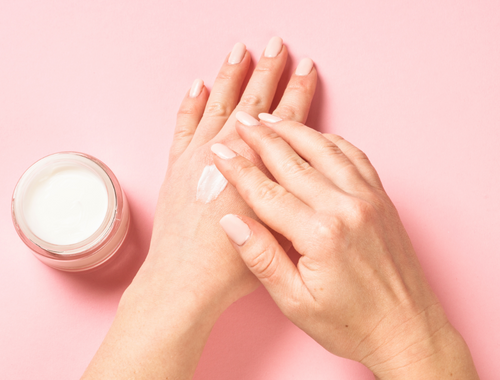Difference Between Emollient and Occlusive
The key to identifying the best skincare products for your skin is to understand the difference between dry skin and dehydrated skin. Many genetic and environmental factors affect your skin barrier. UV radiation, aging, diet, stress, humid and dry environments, and many other factors play a crucial role in the delayed repair of the epidermal barrier. So, it’s important to understand when to use a moisturizer and when to use humectants. So, basically moisturizers create a protective barrier that locks in hydration and prevents water loss. For a better moisturizing experience, it’s important to know that there are two essential moisturizing ingredients that work together to protect your skin – emollients and occlusives.

Emollient
Emollients are generally lipids and oils, which play a major role in filling the crevices between desquamating corneocytes, thereby keeping the skin soft, smooth and moisturized. Emollients are important moisturizing ingredients that not only help provide instant lubrication, they have also been shown to improve barrier repair. Emollients are designed to increase the water content indirectly by creating an occlusive film on the surface of the skin, thereby keeping it supple, so the skin feels more comfortable. Such ingredients go deep into the skin to help soothe and hydrate it, while keeping the moisture trapped with a protective film, providing instant feel of moisturization. Simply put, emollient is an essential skin conditioning ingredient that you can find in your moisturizers.

Occlusive
Occlusives are skin conditioning agents that create a physical barrier on the skin to trap moisture and prevent it from evaporating into the environment. So, they help maintain the water content of the skin to lock in hydration. Such ingredients tend to be heavy, greasy, and function best when applied to slightly dampened skin. Vaseline is a good example of occlusive moisturizer. Ingredients that are known occlusives include petrolatum, cocoa butter, dimethicone, lanolin, squalane, shea butter, and mineral oils. Occlusives are frequently combined with ingredients to help improve the feel, particularly for dry or damaged skin. Occlusives are great for people with extremely dry, irritated skin, or those with some sort of skin condition like eczema or sorts.
Difference between Emollient and Occlusive
Common Ingredients
– There are three types of ingredients you can find in moisturizers: occlusives, emollients, and humectants. Emollients are generally lipids and oils, which play a major role in filling the crevices between desquamating corneocytes. Ingredients like plant oils, mineral oils, shea butter, petrolatum, fatty acids, isopropyl palmitate, etc. are common examples of emollients. Occlusives are skin conditioning agents and ingredients that are known occlusives include petrolatum, cocoa butter, dimethicone, lanolin, squalane, shea butter, mineral oils, silicones, waxes like carnauba or beeswax, and so on.
Skin Care
– Emollients are designed to increase the water content indirectly by creating an occlusive film on the surface of the skin, thereby keeping it supple, so the skin feels more comfortable. So simply put, emollients restore the skin barrier to make the skin surface smooth providing instant feel of moisturization. Occlusives, on the other hand, are moisturizing ingredients that create a physical barrier on the skin to trap moisture and prevent it from evaporating into the environment. So, they help maintain the water content of the skin to lock in hydration.
Emollient vs. Occlusive: Comparison Chart

Summary
While both emollients and occlusives serve different purposes, many occlusive and humectants ingredients can also be emollients. Some ingredients can provide the best of both the worlds. By combining emollients with different properties, formulators can tune the way how moisturizer feels, so you can get a rich, hydrated skin. Most occlusive moisturizers tend to be heavy and oil based, and a good example of this is Vaseline petroleum jelly. Occlusives are effective against extremely dry, irritated skin, or skin conditions like eczema. Emollients are lipids and oils, and are good for most skin types, ideally for soothing and healing dry skin. The best kinds of moisturizers are emollients, ingredients that fill in the gaps between skin cells. At the end of the day, you should choose products that are best suited for your skin type.
What is the difference between emollient humectant and occlusive?
Humectants attract and trap water from the dermis and the humid environment, so it can remain on the surface of the skin. They are often used in conjunction with an occlusive agent to reduce moisture loss. Emollients keep the moisture trapped with a protective film and occlusives help maintain the water content of the skin to lock in hydration.
What is the difference between an emollient and a humectant?
Emollients are designed to increase the water content indirectly by creating an occlusive film on the surface of the skin whereas humectants pull water into the skin to keep things moist.
Is Vaseline an emollient or occlusive?
Vaseline is a good example of occlusive moisturizer because it is heavy, greasy, and functions best when applied to slightly dampened skin.
Is shea butter emollient or occlusive?
Shea butter is a multitasking ingredient that acts both as an emollient and occlusive. It helps soften or smoothen dry skin and also acts as a barrier for your skin.
- Difference Between Caucus and Primary - June 18, 2024
- Difference Between PPO and POS - May 30, 2024
- Difference Between RFID and NFC - May 28, 2024
Search DifferenceBetween.net :
Leave a Response
References :
[0]Kanerva, L., et al. Handbook of Occupational Dermatology. Berlin, Germany: Springer, 2013. Print
[1]Alam, Murad, et al. Cosmetic Dermatology. New York, United States: Elsevier Health Sciences, 2009. Print
[2]Brandt, Frederick. 10 Minutes/10 Years: Your Definitive Guide to a Beautiful and Youthful Appearance. New York, United States: Simon and Schuster, 2007. Print
